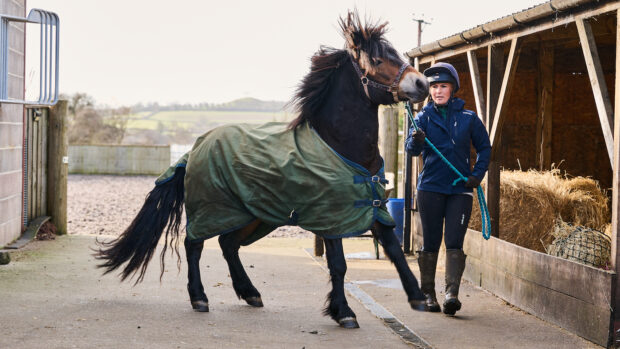Julie Templeton is a leading producer of children’s show ponies; her team has had wins at both the Royal International Horse Show (RIHS) and Horse of the Year Show (HOYS). She has been involved in training horses all her life and is
based in Shropshire with her co-producer, Fiona Wallace.
Training the stars
Colbeach Salaman (Ralph) and I spent a lot of time on the long-reins together. He was only 12.2hh, but had the personality of a lion and a stride that was difficult for a jockey to sit to.
Long-reining proved to be the schooling method that suited him. It allowed me to keep my staff and children safe while educating him, until I knew I could contain and control him in a way his rider could emulate. He went on to be a big winner and part of his show preparation was to get him back on the long-reins.
It could be said that long-reining is the most essential part of the backing process. It establishes pace and direction, and allows your horse to find balance in all gaits before a rider is introduced.
It also establishes the concept of going forward into a contact, which is important in the early stages. If you don’t have long-reining experience, practise with an older, experienced horse first — it’s not ideal to have two novices learning together.
Long-reining can be a tool to introduce lateral work, and is especially helpful for reschooling when your horse needs to return to work without a rider. It’s also great for schooling your horse without endangering the rider. Napping is a great example; you can drive the horse forward if he is established in his napping.
Tackling the issue
1. I use a bridle with a bit, plus either a saddle or a roller, with two lunge-lines clipped on to the bit and passed through the D-rings or stirrups. I attach the stirrups to the girth with a Velcro strap for more stability and a consistent contact.
2. First, I long-rein around the yard in long, straight lines until my horse is confident. Then I’ll build in turning and corners. Once brakes and direction are in place, we can move into the arena.
3. Have someone lead your horse for the first few times. Use your voice and gently flick his sides with the reins to encourage him to go forward. Hold the reins as you would do if you were riding; you need to keep the contact subtle and elastic.
4. Make sure your horse is going straight and forward, as you would when riding him. Once the walk is established, you can proceed to faster paces on a circle, ensuring you work equally in both directions.
Article continues below…
You might also be interested in:

#SundaySchool: showing supremo on the importance of using lateral work
This is a simple leg-yielding exercise from Sue-Helen Shuttleworth (pictured) for both established and young horses, enabling the rider to

#SundaySchool: How can I achieve a soft contact?
Dressage rider Jessica Dunn explains how to achieve harmony in the hand and stop a horse resisting the bridle

Subscribe to Horse & Hound magazine today – and enjoy unlimited website access all year round
Consider this…
- Always wear gloves to protect your hands when long-reining.
- Avoid getting left behind — your horse should not be steaming ahead as this can make you pull on the reins, preventing you from driving him forward.
- Ensure the bit is in the correct place — once an animal learns to get his tongue over, this is a difficult habit to correct.
- Use an appropriate bit, as too strong a bit will encourage your horse to overbend rather than take the contact forward.
- You need to be fit to keep up with your horse’s pace. You also need enough stamina to be able to persevere with solving a problem, or it will be even more difficult the next time you attempt it.
Would you like to read Horse & Hound’s independent journalism without any adverts? Join Horse & Hound Plus today and you can read all articles on HorseandHound.co.uk completely ad-free




